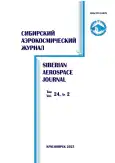Formation of an approach to modeling orbital operations assembly of a reconfigurable spacecraft on geostationary orbit
- Authors: Koroleva Y.L.1, Hohlov A.I.1, Nikolaev D.A.1, Borisova N.V.1, Mathynenko M.G.1
-
Affiliations:
- JSC Academician M. F. Reshetnev “Information Satellite Systems” (RESHETNEV JSC)
- Issue: Vol 24, No 2 (2023)
- Section: Section 2. Aviation and Space Technology
- Published:
- URL: https://journals.eco-vector.com/2712-8970/article/view/622826
- ID: 622826
Cite item
Full Text
Abstract
The aim of the study is to form an approach to modeling the operations of the orbital assembly of a reconfigurable spacecraft (RS) in geostationary orbit. Reconfigurable spacecraft are a set of modular spacecraft (MS), where, in a particular case, one MS can be assigned the functions of the service systems module (MSS), and the second - the functions of the payload module (MPN). To ensure the assembly of the RC, or the replacement of some MC, for example, in case of its failure with a new one, it is necessary to provide a solution to the problem of bringing the MS with the RS.
The article analyzes and studies the operation of the motion control system of the MS during the convergence of the MS with the RS. A list of necessary mathematical models for performing operations in solving the problem of convergence of the MS with the RS is formed, and a block diagram of the interaction of mathematical models is presented. The paper presents a brief description of the mathematical apparatus that allows modeling the operations of convergence of the MS with the RS. This mathematical apparatus includes: a model of the orbital motion of the MS and the RS, models of the angular motion of the MS and the RS, sensitive elements and executive bodies.
In this paper, the mathematical modeling of the MS with the RS convergence operations is considered as the subject of research. The object of the study is the motion control system of the MS, which ensures the implementation of the approach of the RS in geostationary orbit.
About the authors
Yulia L. Koroleva
JSC Academician M. F. Reshetnev “Information Satellite Systems” (RESHETNEV JSC)
Author for correspondence.
Email: korolevayl@iss-reshetnev.ru
engineer
Russian Federation, ZheleznogorskAnton I. Hohlov
JSC Academician M. F. Reshetnev “Information Satellite Systems” (RESHETNEV JSC)
Email: hohlovai@iss-reshetnev.ru
leading Design Engineer
Russian Federation, ZheleznogorskDmitry A. Nikolaev
JSC Academician M. F. Reshetnev “Information Satellite Systems” (RESHETNEV JSC)
Email: nikolaevda@iss-reshetnev.ru
design engineer of the 3rd category
Russian Federation, ZheleznogorskNatalia V. Borisova
JSC Academician M. F. Reshetnev “Information Satellite Systems” (RESHETNEV JSC)
Email: borisovanv@iss-reshetnev.ru
design engineer of the 3rd category
Russian Federation, ZheleznogorskMikhail G. Mathynenko
JSC Academician M. F. Reshetnev “Information Satellite Systems” (RESHETNEV JSC)
Email: mathylenko@iss-reshetnev.ru
Deputy Head of the Department
Russian Federation, ZheleznogorskReferences
- Katkalov V. B. [Space services and operations: status and prospects]. Kosmicheskie uslugi i oper-atsii: sostoyanie i perspektivy. 2020, No. 2, P. 72–74 (In Russ.).
- Goncharevsky V. S. Metody i algoritmy upravleniya otnositel'nym dvizheniem kosmicheskikh appa-ratov [Methods and algorithms for controlling the relative motion of spacecraft]. Moscow, MO RF Publ., 1998, 87 p.
- Ivashkin V. V. Optimizatsiya kosmicheskikh manevrov [Optimization of space maneuvers]. Mos-cow, Nauka Publ., 1975, 392 p.
- Lebedev V. B., Sokolov A. A. Vstrecha na orbite [Meeting in orbit]. Moscow, Mashinostroenie Publ., 1969,178 p.
- Avdeev Yu. F. Polet kosmicheskikh apparatov: primery i zadachi [Spacecraft flight: examples and tasks]. Moscow, 1990, 270 p.
- Eljasberg P. E. Vvedenie v teoriyu poleta iskusstvennykh sputnikov Zemli [Introduction to the theo-ry of flight of artificial Earth satellites]. Moscow, Nauka Publ., 2011, 303 p.
- Balakhontsev V. G., Ivanov V. A., Shabanov V. I. Sblizhenie v kosmose [Rendezvous in space]. Moscow, Voenizdat Publ., 1973, 367 p.
- Grozdovsky G. L., Ivanov V. N., Tokarev V. V. Mekhanika kosmicheskogo poleta s maloy tyagoy [Mechanics of low-thrust space flight]. Moscow, Nauka Publ., 1966, 680 p.
- Efanov V. V., Shevalev I. L. Proektirovanie avtomaticheskikh kosmicheskikh apparatov dlya fun-damental'nykh nauchnykh issledovaniy [Design of automatic spacecraft for fundamental scientific research]. Ed. V. V. Efanov, K. M. Pichkhadze. Moscow, MAI Publ., 2012, 526 p.
- Batrakov A. S., Anatolyev A. Yu. [Mathematical model for predicting linear resolution of optoe-lectronic remote sensing systems]. Opticheskiy zhurnal. 2000, No. 7, 92–99 p. (In Russ.).
- Kosarev N. S., Gerbakov A. S. Statistical analysis of the effectiveness of the use of satellites us-ing GLONASS and GPS. Bulletin of the University. 2014, № 4 (32). 9-15 p.
- Khizhnyak N. Sputnik CleanSpace One gotovitsya k general'noy uborke nashey orbity ot musora [The CleanSpace One satellite is preparing for a general cleaning of our orbit from debris]. Avail-able at: https://hi-news.ru/technology/sputnik-cleanspace-one-gotovitsya-k-generalnoj-uborke-nashej-orbity-ot-musora.html/amp (accassed: 29.05.2023).
- Smet G., Patti S. Mechanisms' View on Micro–vibration – Best practices and Lessons Learned. 44th Symposium on Aerospace Mechanisms. Cleveland, Ohio, 2018, 28 p.
- Evaluation of vibrations emitted by a jet wheel for a Large Space Telescope. NASA Technical Report, 1976, No. 76-18213, 74 p.
- Judges J., Shulman J. Orbital measurements of dynamic disturbances of the thematic cartogra-pher Landsat-4. 35th International Astronautical Federation. 1984, P. 94–117.
Supplementary files







